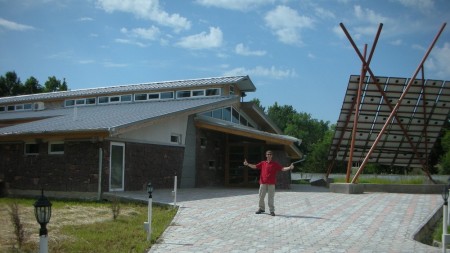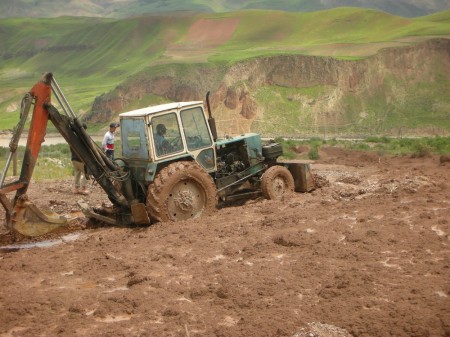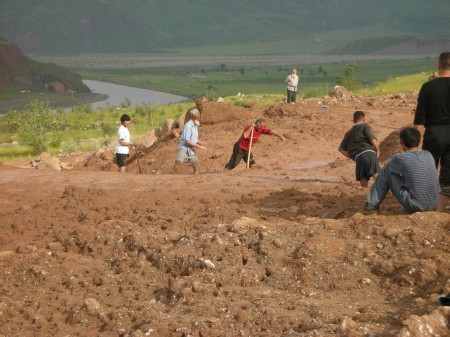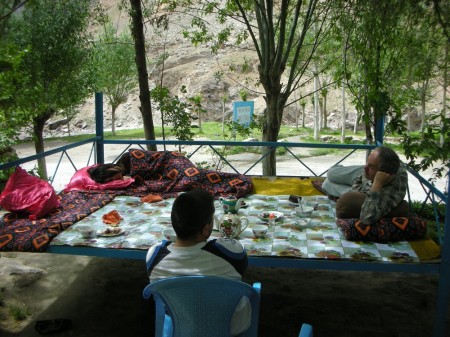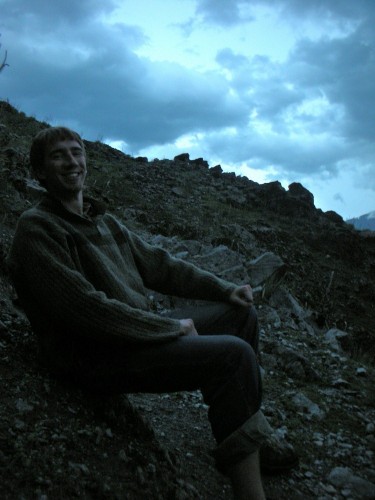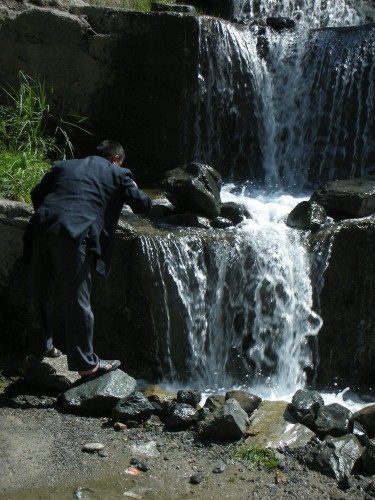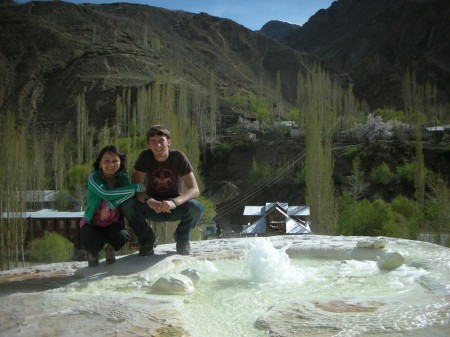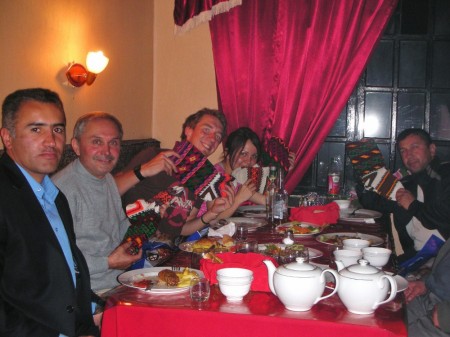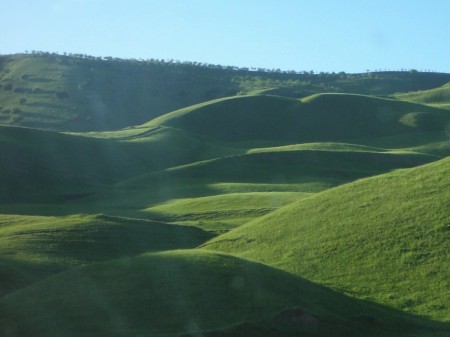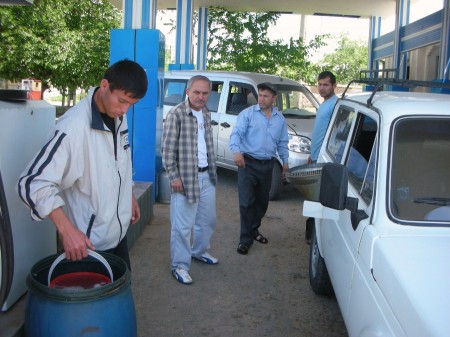After the 8 hours spent along the banks of the Panj River waiting for a mudslide to be cleared, I should have expected that there would be a good chance I’d see more of the same, and I was right. Malik and I were on our way towards the Tajiki city of Panjakent with our hired driver Shirehlee (yes, it is very close to how we’d say “Shirley”) through the snow-covered northern mountains when we were waylaid by a Chinese road construction team for four hours, joining yet another convoy. I thought I would be done with convoys! But such is life – the problem is that the Chinese building group had no idea when they’d be done, or when they started, or when they might stop, and even worse is that this isn’t communicated through any centralized radio network that a driver can tune into. As it was just the two of us and Shirehlee, Malik stretched out in the backseat and napped and I read the final chapters of the last book in the Dune Trilogy that I had gotten for Christmas, six months earlier.
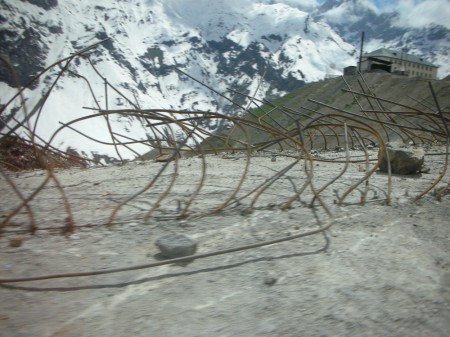
The light and shadows through the rebar tunnel construction made for some interesting mountain scenery
When we at last rumbled into Panjakent at close to midnight, we were enthusiastically greeted by Rauof, the director of the Panjakent archeology facility and a very close friend of Malik’s. He entertained us late into the night with stories about his years working in Paris with such joviality and camaraderie that I thought for the first hour that he must have been Malik’s old university roommate or something. He poured us shot after shot of vodka, downing them all joyfully and with exquisite toasts to our health and families, his fluffy mop of salt and pepper colored hair bobbing erratically, giving him the look of a Central-Asian Andrew Jackson. His driver sat near by, a quiet young man who worked at the archeology excavation site just a few kilometers outside the city limits of Panjakent. Rauof and Malik offered him drinks, which he quietly declined – probably best for his employer’s safety on the ride home!
Our intention was to enter Uzbekistan by 9 in the morning, meet our tour guide at the border, and be in Bukhara just after lunch. However, disaster struck us at the border: the Uzbek guards refused to let Malik enter the country, saying that his official visa pass was not enough and in order for him to use this particular border entrance, he needed to have special faxed documentation for a travel necessity – random tourism of Bukhara was apparently not enough of a necessity. The problem is that the Uzbeks and the Tajiks dislike each other on principle, and the governments of each country even more so. The two border facilities on each side of the no man’s land, for example, weren’t even on speaking terms with each other. To make matters worse, the southeastern corner of Uzbekistan that contains the most famous cities and landmarks is essentially a part of Tajikistan because the majority of the people there identify as Tajik, including speaking Tajik instead of Uzbek languages! This is a sore idea for the Uzbek government which enjoys receiving loads of tourist money from these cities and certainly has no intention of returning the region to Tajikistan just because the inhabitants are Tajiki. It passed laws on those borders saying that neither Uzbeks nor Tajiks can cross that particular border there. Malik didn’t know for sure, but he speculated that it was because the Uzbek government is trying to prevent nationalist feelings of uprising or secession in their Tajiki holdings by limiting their access to Tajikistan, and vice versa. Whatever the case, I knew that I couldn’t just throw my $200 visa away – we still had our tour guide waiting for us, after all. I bid Malik a sad, worried farewell and took my first unguided, untranslated steps into Uzbekistan alone.
I was met by a thin, dour-faced young man named Akbar, a Samarqand native who would be my driver for the next four days. He spoke only a little English, and was a little put-off by the fact that I arrived alone, fact he communicated to me with his questioning sign printed with Malik’s name. Although Malik had written a note for me in Tajiki (which all Samarqand natives speak) for him, he still needed verification of this from the tour guide office before we could begin our four-hour drive to Bukhara.
Here so close to the border with Tajikistan, the villages and towns our white Chevy sedan passed through were quite similar to those that I’d seen for the past week, but the obvious differences were in the language – the official language of Uzbekistan uses the Roman alphabet instead of Cyrillic, and in fact looks and sounds a lot like Turkish. Good thing I’m now an expert on Turkish after my one day in Istanbul. The other very noticeable difference was in the mountains or lack thereof: after moving away from the border, the land quickly flattened out until everything looked like Wisconsin farmland as far as the eye could see, the mountains merely vague shadowy pillars on the horizon behind us.
By far the most surprising stop we made was in the middle of Samarqand, where Akbar got out, instructed me to wait a moment, and returned with a stack of money so large that I assumed he had robbed a bank and I was now an internationally-wanted criminal. It wasn’t until later that I learned that the Uzbek form of currency, the СУМ (or as we’d pronounce it, the saum), is extremely unwieldly, and goes by a base of 100 saum, with their largest note being only 1000 saum. This means, of course, that a lunch might be 7,000 saum, and a hotel room might be 30,000 saum – which would mean 7 or 30 notes. That 15 centimeter stack of notes that Akbar stuffed into the glove compartment next to me would only last a few days.
Before reaching the city, we stopped briefly at the workshop of the famous ceramic, pottery, and linencraft artisan, Abdullah Narzullav, who solemnly led me around his workshop, firing kiln room, and of course provided Akbar and I with fresh tea, berries, and nuts in some of his handmade ceramicwork. I learned that his family had been working in pottery for 6 generations, and when I looked over at his wall of photographs, I saw pictures of him presenting Queen Elizabeth and First Lady Hillary Clinton with half-meter wide plates, as well as a signed letter of thanks from Ms. Clinton. There were many other royalties there, like a prince of Saudi, but no one else I could name off the top of my head. I looked at the quiet, sedately-smiling Abdullah with new respect, and bought a few small items that I could fit into my luggage.
In only a half hour more, Akbar had deposited me at the front door of the Komil Boutique Hotel with a promise that he would pick me up the next morning at 8. The owner of the hotel was aptly named Komil, a young man only a little older than myself. Apparently, this hotel had been his family’s house for generations, and after he became the man of the house, he decided that the home’s beautiful carvings, both in stone and wood, were too beautiful to be kept to himself. Check out some of the pictures from his website, and definitely keep them in mind if you’re ever in the area. Komil told me he had called my guide and she was on her way here, giving me a half hour to shower and change after my long car ride.


